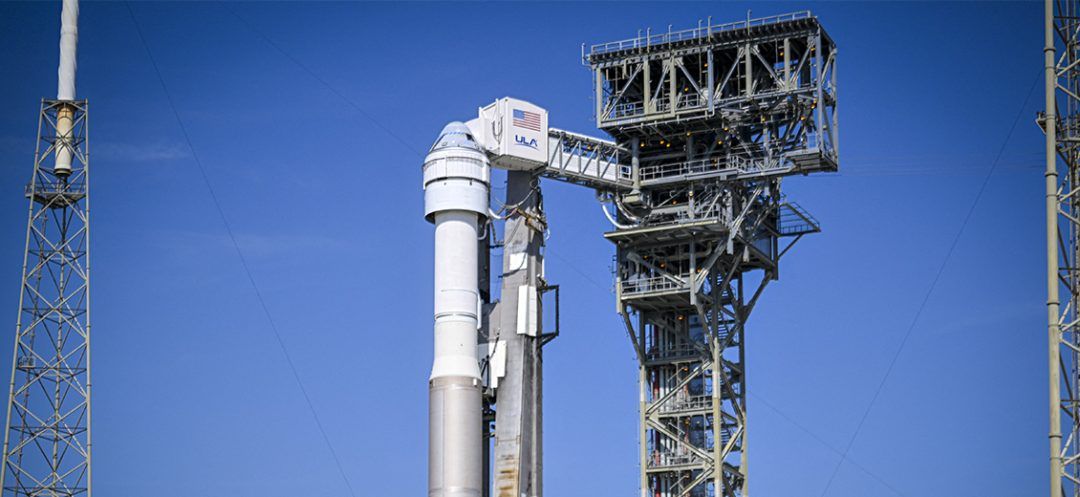
©(Miguel Rodriguez / AFP)
Troubled aerospace giant Boeing has again had to postpone the launch of its first crew to the International Space Station aboard a Starliner spacecraft on Saturday, after the latest attempt was cancelled just hours before liftoff.
Liftoff of Boeing's Starliner spacecraft was canceled on Saturday with less than four minutes to go, due to a technical problem that was not immediately clear, Nasa announced.
This is the second postponement in less than a month for this mission, which will enable Starliner to carry Nasa astronauts to the International Space Station (ISS) for the first time.
Liftoff was scheduled for Saturday at 12:25 p.m. from Cape Canaveral, Florida (16:25 GMT). Nasa astronauts Butch Wilmore and Suni Williams, two space veterans, were aboard the Starliner capsule atop a ULA Atlas V rocket.
But the countdown was stopped at the last moment by a system that engaged automatically, for a reason as yet unknown, explained Nasa.
Teams from ULA, Boeing and Nasa then began to put the rocket into a safe configuration so that the two astronauts could exit.
Alternate liftoff dates are theoretically possible on Sunday, as well as next Wednesday or Thursday, but analysis of the problem encountered will have to be completed before a new date can be announced.
Ten years ago, Nasa ordered two new vehicles from American companies Boeing and SpaceX, to carry the crew into orbit.
NASA is looking to certify Boeing as a second commercial operator to ferry crews to the ISS — something Elon Musk's SpaceX has already been doing for the US space agency for four years.
Both companies received multibillion-dollar contracts in 2014 to develop their gumdrop-shaped, autonomously piloted crew capsules, following the end of the Space Shuttle program in 2011 that left the US temporarily reliant on Russian rockets for rides.
Boeing, with its 100-year history, was heavily favored over its then-upstart competitor, but its program has faced years of delays and safety scares that mirror the myriad problems afflicting its commercial airline division.
Wilmore and Williams were strapped in and ready to blast off on May 6, when a faulty rocket valve forced ground teams to call off that launch.
Since then, a small helium leak located in one of the spacecraft's thrusters has come to light, but rather than replace the seal, which would require taking Starliner apart in its factory, NASA and Boeing officials declared it's safe enough to fly as is.
Pre-launch tests conducted by ground teams on Saturday confirmed the leak had not deteriorated further.
Once in space, the astronauts will put Starliner through the wringer, including taking manual control of the spacecraft.
A successful flight would help Boeing dispel some of the reputational damage sustained by successive failures over the years, from a software bug that put the spaceship on a bad trajectory on its first uncrewed test to the discovery that the cabin was filled with flammable electrical tape after the second.
It's also important for more immediate reasons: the Urine Processor Assembly on the ISS, which recycles water from astronauts' urine, suffered a failure this week, and its pump needs to be replaced, Dana Weigel, NASA's ISS program manager, told reporters.
This mission will thus be tasked with carrying spare equipment, which weighs around 150 pounds (70 kilograms). To make way for it, two astronauts' suitcases containing clothes and toiletries had to be pulled off, meaning they'd need to rely on backup supplies kept on the station.
Starliner is poised to become just the sixth type of US-built spaceship to fly NASA astronauts, following the Mercury, Gemini, and Apollo programs in the 1960s-70s, the Space Shuttle from 1981-2011, and SpaceX's Crew Dragon from 2020.
The seventh spaceship should be NASA's Orion capsule on the Artemis II mission aiming to orbit the Moon next year.
If all goes according to plan, the Starliner should dock with the ISS on Sunday and remain there for eight days as the crew carries out tests, including simulating whether the ship can be used as a safe haven in the event there is a problem on the ISS.
It would then undock, reenter the atmosphere, and carry out a parachute and airbag-assisted landing in the western United States on June 10.
Gianrigo Marletta and Issam Ahmed, with AFP
Liftoff of Boeing's Starliner spacecraft was canceled on Saturday with less than four minutes to go, due to a technical problem that was not immediately clear, Nasa announced.
This is the second postponement in less than a month for this mission, which will enable Starliner to carry Nasa astronauts to the International Space Station (ISS) for the first time.
Liftoff was scheduled for Saturday at 12:25 p.m. from Cape Canaveral, Florida (16:25 GMT). Nasa astronauts Butch Wilmore and Suni Williams, two space veterans, were aboard the Starliner capsule atop a ULA Atlas V rocket.
But the countdown was stopped at the last moment by a system that engaged automatically, for a reason as yet unknown, explained Nasa.
Teams from ULA, Boeing and Nasa then began to put the rocket into a safe configuration so that the two astronauts could exit.
Alternate liftoff dates are theoretically possible on Sunday, as well as next Wednesday or Thursday, but analysis of the problem encountered will have to be completed before a new date can be announced.
Ten years ago, Nasa ordered two new vehicles from American companies Boeing and SpaceX, to carry the crew into orbit.
NASA is looking to certify Boeing as a second commercial operator to ferry crews to the ISS — something Elon Musk's SpaceX has already been doing for the US space agency for four years.
Both companies received multibillion-dollar contracts in 2014 to develop their gumdrop-shaped, autonomously piloted crew capsules, following the end of the Space Shuttle program in 2011 that left the US temporarily reliant on Russian rockets for rides.
Boeing, with its 100-year history, was heavily favored over its then-upstart competitor, but its program has faced years of delays and safety scares that mirror the myriad problems afflicting its commercial airline division.
Wilmore and Williams were strapped in and ready to blast off on May 6, when a faulty rocket valve forced ground teams to call off that launch.
Urine Pump
Since then, a small helium leak located in one of the spacecraft's thrusters has come to light, but rather than replace the seal, which would require taking Starliner apart in its factory, NASA and Boeing officials declared it's safe enough to fly as is.
Pre-launch tests conducted by ground teams on Saturday confirmed the leak had not deteriorated further.
Once in space, the astronauts will put Starliner through the wringer, including taking manual control of the spacecraft.
A successful flight would help Boeing dispel some of the reputational damage sustained by successive failures over the years, from a software bug that put the spaceship on a bad trajectory on its first uncrewed test to the discovery that the cabin was filled with flammable electrical tape after the second.
It's also important for more immediate reasons: the Urine Processor Assembly on the ISS, which recycles water from astronauts' urine, suffered a failure this week, and its pump needs to be replaced, Dana Weigel, NASA's ISS program manager, told reporters.
This mission will thus be tasked with carrying spare equipment, which weighs around 150 pounds (70 kilograms). To make way for it, two astronauts' suitcases containing clothes and toiletries had to be pulled off, meaning they'd need to rely on backup supplies kept on the station.
Elite Club
Starliner is poised to become just the sixth type of US-built spaceship to fly NASA astronauts, following the Mercury, Gemini, and Apollo programs in the 1960s-70s, the Space Shuttle from 1981-2011, and SpaceX's Crew Dragon from 2020.
The seventh spaceship should be NASA's Orion capsule on the Artemis II mission aiming to orbit the Moon next year.
If all goes according to plan, the Starliner should dock with the ISS on Sunday and remain there for eight days as the crew carries out tests, including simulating whether the ship can be used as a safe haven in the event there is a problem on the ISS.
It would then undock, reenter the atmosphere, and carry out a parachute and airbag-assisted landing in the western United States on June 10.
Gianrigo Marletta and Issam Ahmed, with AFP
Read more




Comments